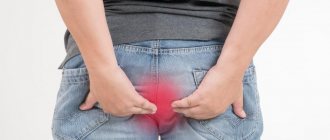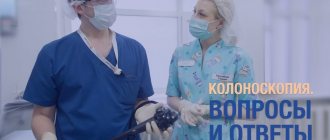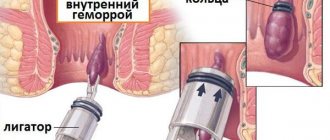More about the disease
Colon diverticulosis is a pathological condition expressed by dystrophic changes in the muscular wall of the large intestine, manifested by the formation of small pouch-like protrusions - diverticula.
They can be congenital or acquired, single or multiple, and can be complicated by bleeding, inflammation and perforation. Elderly people are especially susceptible to the disease, since the elasticity of the intestinal walls decreases significantly with age. Due to regular constipation, increased gas formation, the pressure in the intestines increases, which contributes to the protrusion of weakened areas - a diverticulum is formed. Treatment of diverticulosis can be conservative or surgical. Therapeutic tactics are determined depending on the clinical manifestations of the disease and the severity of its course.
Benefits of treatment at GMS Hospital
GMS clinic specialists use the latest methods of conservative and surgical treatment of colon diverticulosis. Our abdominal surgery department has a modern operating unit equipped with advanced equipment, intensive care wards and a comfortable hospital.
The main advantages of diverticulum treatment at GMS Hospital:
- an integrated approach to treatment - the patient is observed not only by the surgeon, but also by doctors of related specialties;
- the use of modern diagnostic techniques will make it possible to detect even minimal inflammatory changes in the intestinal walls;
- our experienced doctors successfully treat even complicated and advanced forms of diverticulosis;
- For surgical treatment, the latest minimally invasive techniques are used, aimed at speedy rehabilitation;
- Early postoperative rehabilitation takes place in a comfortable hospital with cozy wards.
Most surgical interventions are performed laparoscopically, which reduces the hospital stay and recovery period by several times. Making an appointment with a doctor at GMS Hospital is possible around the clock - by phone or online.
Signs, symptoms of the disease
Diverticula of the colon may not be detected for a long time and are detected during examination of the intestine. The following symptoms may indicate the presence of diverticula:
- regular constipation;
- increased formation of intestinal gases;
- bowel dysfunction in which constipation is replaced by diarrhea;
- frequent cramping pain in the abdomen;
- bloating;
- nausea, vomiting.
- bloody stools.
In the acute form of the disease, fever is added to the symptoms.
Violation of the integrity of the diverticulum (rupture, perforation) is accompanied by a clinical picture of an “acute abdomen” - a tense and hard abdominal wall, rapid pulse, low blood pressure, cold sweat. With intestinal bleeding, scarlet blood is found in the stool. If the first alarming symptom occurs, consult a doctor immediately. You can make an appointment with a surgeon at the GMS clinic around the clock.
Western standards of treatment (evidence-based medicine)
Continuous staff development
Regular interaction with leading Russian and foreign medical institutions
Modern medical equipment and advanced diagnostic and treatment methods
Unified standard of service
We work around the clock 24/7/365
Make an appointment We will be happy to answer any questions Coordinator Oksana
Diagnostic methods
If you have a problem, you need to contact a gastroenterologist or proctologist. The doctor will evaluate your symptoms and conduct an examination. With uncomplicated rectal diverticulum, ultrasound and instrumental examination are sufficient to confirm the diagnosis. For lesions of the colon with complications, the patient is prescribed:
- irrigoscopy - radiography with contrast;
- colonoscopy – endoscopy of the lower intestine through the anus.
In an acute condition, the patient needs to undergo a blood test. With diverticulitis, white blood cell counts will be elevated.
Causes of diverticulosis
Various factors contribute to the formation of diverticula:
- congenital connective tissue dysplasia;
- dystrophic changes in the muscle wall of the intestine;
- disturbance of intestinal motility;
- poor nutrition – exclusion of fiber, predominance of meat and flour products;
- regular constipation;
- overweight;
- infectious and inflammatory bowel diseases;
- physical inactivity;
- indiscriminate and prolonged use of laxatives.
Diverticula tend to progress with age - increased pressure in the intestine causes a pulsation (squeezing) effect on weakened areas of the intestine, which causes the formation of new protrusions.
Diagnostics
Since the clinical picture of colon diverticulosis is similar to the signs of many other diseases, a comprehensive differential diagnosis is carried out, including:
- blood tests;
- irrigography with contrast (in the absence of symptoms of perforation);
- plain X-ray of the abdominal cavity;
- sigmoidoscopy, colonoscopy (performed after elimination of inflammation);
- Ultrasound, CT scan of the abdominal cavity.
Our clinic employs doctors with many years of experience in the field of abdominal surgery, who will quickly make the correct diagnosis and select the most effective treatment tactics.
Symptoms, diagnosis of acute appendicitis
The clinical picture of acute appendicitis is varied and does not always occur according to the classical version. The disease usually begins with pain in the right iliac region (lower right abdomen). Quite often, pain appears first in the upper abdomen or throughout the abdomen, and later, after a few hours, it is localized in the right iliac region. The pain is constant. May get worse when walking or coughing. Patients may be bothered by weakness, sometimes there is a single loose stool. If the appendix is located in the pelvis, there may be complaints of frequent urination. An increase in body temperature is typical - usually up to 37.5 - 38.5. During the first 1-2 days, the general condition may not suffer much; some patients complain of moderate weakness and dry mouth.
On palpation there is pain in the right iliac region, positive symptoms of Shchetkin, Rovzing , Sitkovsky, Voskresensky. Obraztsov's symptom may be positive .
A blood test usually shows an elevated white blood cell count.
Treatment methods
For asymptomatic diverticulum, treatment consists of a special diet and adherence to the principle of a healthy diet. Drug treatment of uncomplicated diverticulosis includes:
- antispasmodics and prokinetics - to eliminate pain symptoms and normalize intestinal motility;
- enterosorbents (for flatulence);
- enzymes - to normalize the digestive process;
- pro- and prebiotics – to restore and normalize intestinal microflora;
- Antibacterial therapy – prescribed for the development of diverticulitis.
In case of low effectiveness of conservative therapy and the presence of serious complications, such as perforation, peritonitis, stenosis of the intestinal lumen, surgical intervention is performed.
The operation is performed under general anesthesia. The affected area of the intestine is excised and removed, then the integrity of the intestine is restored by stitching the unaffected areas together. If simultaneous restoration of intestinal continuity is not possible, a stoma is formed (an artificial channel for draining feces). In this case, after 2-3 months, reconstructive surgery will still be needed.
There are two main ways of performing surgery:
- open resection of the colon - the intervention is performed through a large incision in the abdomen;
- laparoscopic resection of the colon - the operation is performed through several small punctures through which surgical instruments connected to a video camera are inserted. The surgeon monitors the progress of the operation using a monitor.
The operation lasts about 2-3 hours, the volume of intervention depends on the stage and degree of the disease, the presence of concomitant pathologies, the patient’s age, general condition and other factors. Laparoscopic resection of the colon at the GMS clinic is performed using modern endoscopic equipment, which provides high-quality images of the operated area at multiple magnification, which allows the operation to be performed with precise precision.
You have questions? We will be happy to answer any questions Coordinator Tatyana
Diagnosis of acute appendicitis
placed on the basis of a cynic picture. Additional methods (ultrasound, x-ray, etc.) are not very informative. In doubtful cases, laparoscopy is performed.
In its development, acute appendicitis undergoes several stages:
- catarrhal appendicitis - initial inflammation, without suppuration in the wall.
- phlegmonous appendicitis - the wall of the appendix is already saturated with pus
- gangrenous appendicitis – necrosis (necrosis) of the appendix wall
- gangrenous-perforated appendicitis - a hole is formed in the necrosis zone through which pus flows into the abdominal cavity, causing peritonitis - purulent inflammation of the peritoneum.
If left untreated, acute appendicitis can have three outcomes:
most often and most likely - progression of inflammation, diffuse peritonitis, death. In the very initial stages, with catarrhal appendicitis, self-healing is possible, say, if the fecal stone clogging the appendix is pushed into the cecum, etc. – this happens extremely rarely and you shouldn’t count on it.
In some cases, the inflammation is limited and goes into the appendiceal infiltrate - tissues - intestinal loops, greater omentum - are welded around the appendix. Within a few days, abscess formation of the infiltrate occurs, and it opens into the intestinal cavity (favorable outcome) or into the abdominal cavity - then peritonitis develops.
Prevention of colon diverticulum
The main way to prevent the disease is to maintain normal intestinal motility, which is facilitated by a balanced healthy diet, including a sufficient amount of fiber-rich foods. Another preventative measure is to drink enough fluids. An active lifestyle, sports, a balanced ratio of rest and work, giving up bad habits, avoiding stress - following these simple recommendations will help keep your intestines normal.
Treatment of colon diverticulosis should be carried out under the supervision of a physician. Self-medication is unacceptable and can not only complicate the course of the disease, but also lead to serious, life-threatening consequences. If you need the help of a competent specialist in the diagnosis and treatment of intestinal diverticulum, sign up for a consultation at the GMS clinic by phone or online.
Causes of rectal condyloma
The human papillomavirus, which causes the development of condyloma in the rectum, is transmitted from person to person through sexual contact or through direct contact of the skin and mucous membranes. Moreover, the infection does not have traditional risk groups. All people who are sexually active can get sick. Barrier methods of contraception do not guarantee protection against human papillomavirus.
Significant risk factors for the development of condyloma in the rectum include:
- Early onset of sexual activity;
- Large number of sexual partners;
- The presence of other sexually transmitted infections.
Scientists know about 100 types of human papillomavirus. 90% of rectal condylomas are caused by viruses of types six and eleven. The disease progresses steadily, but proctologists sometimes observe spontaneous reversal of the disease or long-term stabilization of the pathological process. Condylomas of the rectum are rarely found above the dentate line.







